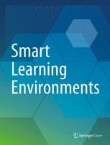Smart Learning Environments is affiliated with the International Association of Smart Learning Environments. This journal is supported by National Engineering Laboratory for Cyberlearning and Intelligent Technology and Smart Learning Institute of Beijing Normal University.
An empirical study of Chinese students' behavioral intentions to adopt 5G for smart-learning in Covid-19
The social distancing due to the Covid-19 epidemic has disturbed all sectors of society, including education. To maintain normal operations, it is necessary to adapt quickly to this situation. Many technologie...
